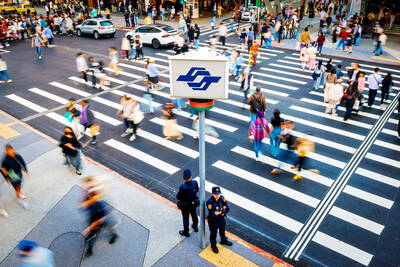The issue with the so-called “1992 consensus” is that there is no consensus about whether it exists or what it actually means, Premier William Lai told legislators yesterday, adding that the nation needs to address the problem.
Lai made the remarks at a plenary legislative session in response to Chinese Nationalist Party (KMT) Legislator Legislator Yosi Takun’s (孔文吉) demand that he and President Tsai Ing-wen (蔡英文) acknowledge the “1992 consensus.”
Citing Chinese Premier Xi Jinping’s (習近平) report to the Chinese Communist Party’s (CCP) 19th National Congress, Yosi Takun said that Tsai and Lai should accept the “historical fact of the 1992 consensus” and resume dialogue with Beijing.

Photo: Liao Chen-huei, Taipei Times
“We are willing to have exchanges with any Taiwanese party, group or individual who… acknowledges the 1992 consensus and believes both the Mainland and Taiwan belongs to ‘one China,’” Xi told the congress on Wednesday.
Lai said Taiwanese society is divided on the “1992 consensus” framework.
“Some think the government should accept the ‘1992 consensus,’ while others believe there is no consensus. Even those who believe that it exists do not believe in China’s version,’” Lai said.
“There are two interpretations of one 1992 consensus,” Lai said, adding that China understands its “1992 consensus” to mean its “one China” ideology, while KMT Chairman Wu Den-yih (吳敦義) believes the framework means that each side can have its own interpretation of what “China” means.
“We need to take this problem seriously,” Lai added.
He said that Taiwan is a sovereign and independent country and that the Executive Yuan would continue to abide by Tsai’s cross-strait directive that the government would not change its goodwill or its promise of maintaining the “status quo,” nor would it compromise under pressure.
The Executive Yuan remains unwavering in its commitment to protect national sovereignty, as well as the nation’s free and democratic way of life, to develop the country’s economy and to strengthen the nation, he said.
“A tacit understanding should not be clarified in the open,” Yosi Takun said, to which Lai said that people need to deal with the issue candidly, as it could have severe ramifications for the future of the country.
Mainland Affairs Council (MAC) Minister Katharine Chang (張小月) said that Xi’s statement was a “carrot-and-stick ploy,” but that the government’s stance is to adhere to the values of freedom and democracy, while demonstrating sincerity and goodwill to the other side.
The “1992 consensus,” a term former MAC chairman Su Chi (蘇起) in 2006 admitted to making up in 2000, refers to a tacit understanding between the KMT and the CCP that both sides of the Taiwan Strait acknowledge there is “one China,” with each side having its own interpretation of what “China” means.

SHIPS, TRAINS AND AUTOMOBILES: The ministry has announced changes to varied transportation industries taking effect soon, with a number of effects for passengers Beginning next month, the post office is canceling signature upon delivery and written inquiry services for international registered small packets in accordance with the new policy of the Universal Postal Union, the Ministry of Transportation and Communications said yesterday. The new policy does not apply to packets that are to be delivered to China, the ministry said. Senders of international registered small packets would receive a NT$10 rebate on postage if the packets are sent from Jan. 1 to March 31, it added. The ministry said that three other policies are also scheduled to take effect next month. International cruise ship operators

HORROR STORIES: One victim recounted not realizing they had been stabbed and seeing people bleeding, while another recalled breaking down in tears after fleeing A man on Friday died after he tried to fight the knife-wielding suspect who went on a stabbing spree near two of Taipei’s busiest metro stations, Taipei Mayor Chiang Wan-an (蔣萬安) said. The 57-year-old man, identified by his family name, Yu (余), encountered the suspect at Exit M7 of Taipei Main Station and immediately tried to stop him, but was fatally wounded and later died, Chiang said, calling the incident “heartbreaking.” Yu’s family would receive at least NT$5 million (US$158,584) in compensation through the Taipei Rapid Transit Corp’s (TRTC) insurance coverage, he said after convening an emergency security response meeting yesterday morning. National

PLANNED: The suspect visited the crime scene before the killings, seeking information on how to access the roof, and had extensively researched a 2014 stabbing incident The suspect in a stabbing attack that killed three people and injured 11 in Taipei on Friday had planned the assault and set fires at other locations earlier in the day, law enforcement officials said yesterday. National Police Agency (NPA) Director-General Chang Jung-hsin (張榮興) said the suspect, a 27-year-old man named Chang Wen (張文), began the attacks at 3:40pm, first setting off smoke bombs on a road, damaging cars and motorbikes. Earlier, Chang Wen set fire to a rental room where he was staying on Gongyuan Road in Zhongzheng District (中正), Chang Jung-hsin said. The suspect later threw smoke grenades near two exits

The Forestry and Nature Conservation Agency yesterday launched a gift box to market honey “certified by a Formosan black bear” in appreciation of a beekeeper’s amicable interaction with a honey-thieving bear. Beekeeper Chih Ming-chen (池明鎮) in January inspected his bee farm in Hualien County’s Jhuosi Township (卓溪) and found that more than 20 beehives had been destroyed and many hives were eaten, with bear droppings and paw prints near the destroyed hives, the agency said. Chih returned to the farm to move the remaining beehives away that evening when he encountered a Formosan black bear only 20m away, the agency said. The bear